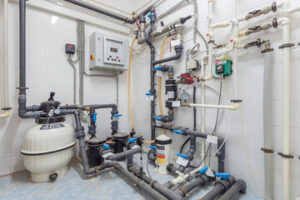Are you currently interested in info on How Does the Plumbing Work in Your Home??

Plumbing is a crucial aspect of any home, responsible for supplying clean water for alcohol consumption, food preparation, and bathing, in addition to removing wastewater securely. Comprehending the essentials of home plumbing is necessary for every single property owner to make certain correct maintenance, troubleshooting, and, if required, repairs. In this beginner's overview, we'll cover the fundamental concepts of home plumbing to assist you end up being extra familiar with exactly how it functions.
Water Heater
The water heating unit is accountable for home heating water for residential usage, consisting of showering, cooking, and cleansing. Usual sorts of water heaters include tank-type water heaters, tankless (on-demand) water heaters, and heat pump hot water heater. The water heater is linked to the water system and supplies warm water to plumbing components as required.
Water drainage System
The drainage system removes wastewater from your home and carries it away to a sewer therapy center or septic tank. It contains a network of pipelines, installations, and components that deliver wastewater from plumbing components to the primary drain line or septic system. Appropriate drainage is important to prevent clogs, backups, and sewer leaks.
Air flow System
The air flow system helps maintain appropriate atmospheric pressure and protect against sewage system gases from entering your home. Vent pipelines, also called vent heaps, extend from plumbing components to the roof, allowing sewage system gases to leave securely outside. Air flow pipes additionally enable air to get in the drain system, assisting in smooth wastewater circulation and avoiding suction or vacuum cleaner effects.
Supply Of Water System
The water system brings clean water into your home from a municipal water source or an exclusive well. It includes a major water line that attaches to your home's plumbing system, normally located underground. A water meter determines the amount of water eaten, while a shut-off shutoff allows you to manage the circulation of water into your home.
Plumbing Fixtures
Plumbing components are devices that supply water to numerous parts of your home and consist of sinks, faucets, toilets, showers, tubs, and appliances such as dish washers and cleaning devices. Each fixture is linked to the water supply system via pipelines and fittings and might have its shut-off shutoff for upkeep or emergency situations.
Common Plumbing Devices
Having the right tools handy is necessary for executing basic plumbing repair services and maintenance jobs. Common plumbing devices include adjustable wrenches, pipe wrenches, pliers, pipe cutters, hacksaws, bettors, augers (or drain serpents), and Teflon tape. Having these tools easily available can assist you tackle small plumbing concerns effectively.
Fundamental Plumbing Repair Services
While some plumbing fixings might call for professional support, many usual problems can be attended to with basic DIY strategies. Knowing just how to fix a dripping tap, unclog a drain, replace a toilet flapper, or repair a trickling showerhead can conserve you time and money on plumbing repairs.
Conclusion
Comprehending the basics of home plumbing is vital for every single homeowner to preserve a secure, useful, and effective plumbing system. By acquainting yourself with the supply of water system, plumbing fixtures, drainage system, ventilation system, common plumbing tools, and fundamental repairs, you can with confidence attend to minor plumbing issues and guarantee your home's plumbing system operates efficiently.
Understanding Basics of Home Plumbing System: A Beginner's Guide
The Main Components of Your Home Plumbing System
The Water Supply System
This system is responsible for transporting fresh water into your home. It usually has a main water line that splits into two branches: one directed towards cold water services and the other connected to a water heater for hot water. The pressure is key here; it ensures water reaches all parts of your house.
The Drainage System
Once water has been used, it becomes wastewater that needs to be removed from your home. This is where the drainage system comes into play. It includes all the pipes that carry wastewater and sewage away from your house to sewage treatment facilities or septic tanks.
The Vent System
The vent system prevents sewer gases from entering your home and helps maintain the pressure balance that allows wastewater to flow out properly. These vents usually exit through the roof of your house.
Water Heating System
For those who enjoy hot showers or using hot water for cleaning, the water heater is a crucial part of the plumbing system. It can be a tankless system, which heats water on demand, or a traditional water tank model.
Common Plumbing Problems and Basic Troubleshooting
Plumbing systems, while designed to be durable, can face issues like clogged drains, leaky faucets, or low water pressure. Here are some basic troubleshooting tips:
Clogged Drains
Use a plunger or a plumber's snake to try and dislodge whatever is blocking the drain. Regular cleaning can prevent clogs.
Leaky Faucets
Often caused by worn-out washers or gaskets, these can usually be replaced by someone with basic DIY skills.
Low Water Pressure
This might be due to sediment build-up in your fixtures or a leak somewhere in your water line. Cleaning out aerators or seeking a professional to detect leaks might be necessary.
Preventive Maintenance Tips
Maintaining your plumbing system is key to avoiding emergencies. Regularly check for leaks, avoid disposing of grease down the sink, and have your system inspected by a professional plumber at least once a year.
As a serious person who reads on What to Know About Plumbing: Basics, Tips, and Insights, I was thinking sharing that excerpt was a good idea. Sharing is nice. You won't know, you may be doing someone a favor. Thank-you for going through it.
Further Details